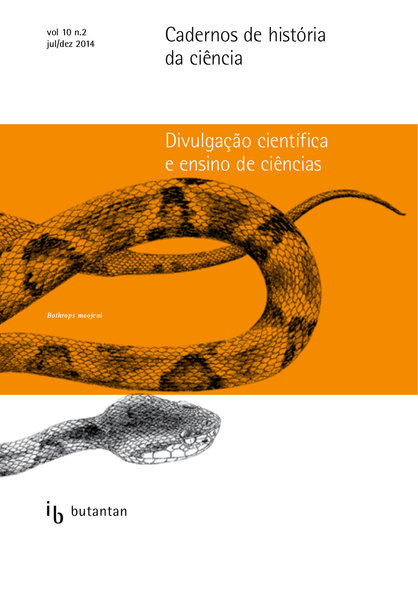Abstract
This article aims to present the experience about the theatrical spectacle 1001 Inventions of Muslim Civilization, and to discuss its possible contributions to the teaching of the history and nature of science. The action, which encompassed 20 public schools, aimed to increase the students’ awareness to the importance of science in the period before the Renaissance and its influences in our present life. The plot is centered on four characters, two men and two women, involved in the development and dissemination of knowledge and technology, as knowledge of Optics and the construction of engines. We collected spectators’ opinions using questionnaires, and it has showed that the spectacle was well received by students and teachers. According to the reports, the students showed interest in learning more about science, technology and their histories and teachers indicated that the play caught the attention of students and could be associated with classroom contents.
References
Brickhouse NW. Should the social epistemology of science be rated x? In: Duachl RA, Grandy RE (Eds.). Teaching Scientific Inquiry: Recommendations for Research and Implementation. Rotterdam, The Netherlands: Sense Publishers, 2008, cap.7, pp.95-98.
Ministério da Ciência, Tecnologia e Inovação (MCTI). Centro de Gestão e Estudos Estratégicos (CGEE). Percepção Pública da Ciência e Tecnologia no
Brasil. [internet]. Acessado em 2/06/2016. Disponível em: <http://percepcaocti.cgee.org.br/>.
Delizoicov D, Angotti JA, Pernambuco MM. Ensino de ciências: fundamentos e métodos. 3.ed. São Paulo: Cortez, 2009. (Coleção Docência em Formação).
Duschl RA. Science Education in Three-Part Harmony: Balancing Conceptual, Epistemic, and Social Learning Goals. Review of Research in Education, v(32), n(1): 268-291, fev. 2008.
______, Grandy RE (Eds.). Teaching Scientific Inquiry: Recommendations for Research and Implementation. In: Teaching Scientific Inquiry: Recommendations for Research and Implementation. Rotterdam, The Netherlands: Sense Publishers, 2008, cap.1, pp.1-37.
Fision KD. Drawing a Scientist: What We Do and Do Not Know After Fifty Years of Drawings. Sch. sci. math., v(102), n(7): 335-345, nov. 2002.
Galili I. Promotion of Cultural Content Knowledge Through the Use of the History and Philosophy of Science. Sci. educ., v(21), n(9): 1283-1316, sep. 2012.
Manzoli F et al. Children’s s perceptions of science and scientists a case study based on drawings and story telling. Science and technology, v(2):3-13, 2006.
Massarani L. A forma como a ciência e o cientista são representados pela mídia pode ser aprimorada: depoimento. [Outubro/2014]. Rio de Janeiro: Hist. Ciênc. Saúde-Manguinhos. Entrevista concedida a Haendel Gomes. [internet] Acessado em 02/06/2016. Disponível em: <http://www.revistahcsm.coc.fiocruz.br/a-forma-como-a-ciencia-e-o-cientista-sao--representados-pela-midia-pode-ser-aprimorada/>.
Mattews MR. História, filosofia e ensino de ciências: a tendência atual de reaproximação. Cad. Catarin. Ensino Fis., Florianópolis, v(12), n(3): 164-214, 1995.
Sasseron LH. Alfabetização científica e documentos oficiais brasileiros: um diálogo na reestruturação do ensino da Física. In: Carvalho AMP, Ricardo EC, Sasseron LH, Santos Adib MLV, Pietrocola IM. Ensino de Física. São Paulo: Cengage Learning, 2010, cap.1, pp.1-27.
Seroglou F, Adúriz-Bravo A. Introduction: The Application of the History and Philosophy of Science in Science Teaching. Sci. educ., v(21), n(6): 767-770, jul. 2012.
Remillard-Hagen E. Lady Mary Wortley Montagu and Smallpox Inoculation in 18th-Century England. [internet]. Acessado em 02/06/2016. Disponível em: <http://www1.umn.edu/ships/modules/biol/smallpox.htm>.
